Honolulu’s Chinatown is one of the oldest Chinatowns in the United States and it has an interesting history.
The AJF and Malt thought a ramble through Tánxiāngshān (the area’s Chinese name meaning “Sandalwood Mountain”) would be interesting, so off we went.
In ancient times, before there was a town called Honolulu, there was village built on mud flats and raised coral called Kou. Nearby was Nuuanu Stream which provided the settlement of Kou with fresh water and created an estuary with rich soils and nourished a fishpond archaeologists have dated to 890 AD. Adjacent was Pukaka Heiau, an Hawaiian temple of healing dedicated to the god Lono.
Kou wasn’t a hugely popular area. In fact, Oahu’s ali`i (royalty) much preferred Waikiki.
Kou offered limited canoe landings while Waikiki enjoyed many channels through the reef for easy beaching of canoes, better surf and closer access to deep sea fishing.
Plus Waikiki was chock-a-block with maitais and semi-naked dancing girls.
Nah, just kidding about that last part.
Except for Hawaiians, Kou never caught on as a name for the area. For a spell, the harbor area was known among foreigners as “Fair Haven.” In turn, Fair Haven fell out of use by the 1820s. Honolulu became the official name of the growing town in 1825 or so, years after the arrival of foreigners began to swell the population. The name Honolulu means “sheltered bay’.
OK, now that we’ve established how Honolulu got its start, here’s where the Chinese come in…
Historians trace the arrival of the first Chinese in Hawaii to 1789 but they were not a significant social force in the islands until the 1850s.
Up to the mid- 1800s the whaling ships that arrived in Honolulu every Spring and Fall dominated Honolulu harbors’ economy.
But as whaling began to decline, sugar plantations became the main industry in the islands. Needing a source of low-cost, controllable and hard working laborers the plantations started recruiting Chinese laborers in large numbers and signing them to 5-year contracts.
When their indenture expired, many of the Chinese immigrants relocated from the plantations to Honolulu’s Chinatown to work for existing businesses or open their own. The name “Chinatown” was first used around 1870 to describe the community of primarily family-run shops.
Chinese immigration to the island kingdom climbed steadily until the political coup in 1893 that unseated Hawaii’s Queen Liliuokalani.
By the mid-1890s, 20% of Hawaii residents were of Chinese descent. Ever industrious. they started families, established schools, newspapers, businesses, cemeteries, temples and ancestral societies. Unlike other groups of immigrants, however, the Chinese did not assimilate well into Hawaiian culture, preferring instead to retain a separate society.
Chinatown in the late 1800s was not pretty. Just the opposite: it was filthy, devoid of sanitary constraints, a ramshackle boomtown of narrow streets, and primitive wood-framed construction. About 7,000 people of diverse ethnicities lived in jammed quarters. There were especially large numbers of Japanese who had succeeded the Chinese as imported plantation workers.
Chinatown had become the hub of organized crime, especially prostitution, a niche business that provided economic entre for new immigrants. At a time when a plantation worker made about $18 a month, Japanese prostitutes were making hundreds of dollars. Surprisingly, in 1900, over 80 percent of Honolulu prostitutes were Japanese; all of the pimps were Japanese. When I pointed this out to the AJF she feigned deafness.
Chinatown was squalor on an epic scale. It was disdained by polite society but while everyone tut-tutted about the horrible conditions, everyone also knew that Chinatown was an economic engine, pumping huge sums into the pockets of the upper classes. Disaster came in the form of the Great Chinatown Fire of 1900 which was a result of an outbreak of bubonic plague.
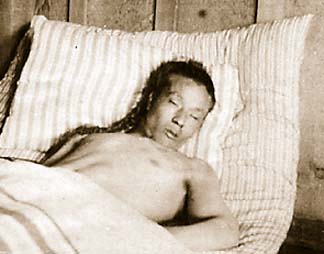
A very rare photo of an actual plague victim in 1900. Neither the victim nor the photographer’s name is known. Photo from the State archives.
The plague reportedly started at the Wing Wo Tai grocery on Nuuanu Avenue when a 22-year old bookkeeper You Chong scratched idly at a flea bite allowing the contagion known as the Black Death to enter his bloodstream.
Untreated, black plague is fatal from 75 – 100 percent of the time depending on the version.
Spread by fleas on rats, the bacillus found perfect conditions to spread in Chinatown.
The bubonic plague had the potential to kill everyone in the islands; there was nowhere to run.
It has been said that next to the Pearl Harbor attack, the outbreak of plague was the greatest public-safety disaster in Hawaiian history. The government was determined to do anything to save the city — even burn it to the ground.
Within hours of doctors diagnosing You Chong, four more cases of bubonic plague were discovered in Chinatown.
The government took action: ships’ passengers were quarantined, schools were closed and disinfected, guards were posted to prevent movement in and out of Chinatown, and monies were appropriated to battle the disease.
A Portuguese band marched up and down the street playing funeral songs to a frightened populace. This was Armageddon level trouble.
After 13 people died, the Board of Health ordered structures suspected of being infected to be burned.
Residents were quickly evacuated, and a few buildings were successfully destroyed while the Honolulu Fire Department stood by. However, the fire got out of control after winds shifted, and destroyed most of the neighborhood instead.
The runaway fire burned for seventeen days and scorched 38 acres of Honolulu.
The fire campaign continued for another 31 controlled burns after the incident. The 7,000 homeless residents were housed in detention camps to maintain the quarantine until April 30. A total of 40 people died of the plague. By June, Honolulu was declared plague-free.

Made in China is not a bad phrase in Chinatown although today the Vietnamese outnumber the Chinese in the neighborhood.
By the 1920s, Chinatown was back on its feet economically speaking but the Chinese population had been shrinking. After the Chinese Exclusion Act of 1882 slowed immigration from China, sugar plantations turned instead to Japanese immigrants and then later Filipinos and Portuguese sources of labor.

You can buy a whole pig’s head in Chinatown. This one looked past its expiration date but seemed surprisingly happy.
By the late 1930s, Chinatown had begun to decline as many of the Chinese residents moved to other areas of Honolulu to live while still keeping their businesses in the district.
During World War II, however, Chinatown enjoyed a new vitality as the “red light district” with cheek-to-cheek nightclubs, restaurants and brothels along Hotel Street with gambling parlors targeted at the military population.
After the booming war years, Chinatown fell into a long slow decline, becoming known as a hotspot for illegal activities.

In the Vietnam war era this bar was the place to go to get into serious trouble. Don’t ask how I know that factoid.
During the 1950s and 1960s, the number of people living in Chinatown continued to drop and businesses began to suffer.
Shopping centers displaced the Chinatown markets, tourism displaced the plantation economy and, with the arrival of Statehood and jet air access, Waikiki grew as the center of Honolulu’ visitor trade.
In 1973, Honolulu’s Chinatown was listed in the National Register of Historic Places as an historic district.
As a result, the area began to revitalize and the city started to invest in Chinatown and its unique history.
Today, Chinatown Historic District is the largest area in Honolulu that reflects an architectural and historic character with a distinctive sense of time and place. While virtually everything pre-1900 was destroyed by the fire, there are secret spots where you can see a glimpse of the past.
The sidewalks, for example, are embedded with some rough looking stones which were originally ballast for clipper ships that arrived in Hawaii, left behind when the hulls were loaded up with the islands’ precious native woods of koa, sandalwood and ohia.
Rather than throw them overboard, the ballast stones were re-purposed as sidewalk pavers.
A Bank of Hawaii branch on King St. looks unassuming from the outside, but inside are teller cages framed in polished wood and a historic drawing of the Honolulu waterfront hanging on the wall.
Look carefully and you’ll see the signs of the Chinese zodiac are represented by medallions embedded into the upper perimeter of the Chinatown Gateway Plaza building and if you know where to look you can spot the Lucky Lions, marble sculptures that guard the eastern gateway to Chinatown on Hotel and Bethel streets.
By day, today’s Honolulu Chinatown is bi-polar. On the one hand the traditional open markets remain popular, especially with Asian immigrants. But it is also all about trendy start-up restaurants of all flavors. By night Chinatown is all about the clubbing scene with bars ranging from dive to swank. It’s about art gallerys and lofts.
It’s still more than bit dirty. It’s more than a little seedy. There are still plenty of rats both bipedal and quadrupedal. Interestingly, there are more Vietnamese than Chinese living in the neighborhood, a sign of the progression of immigrants through Honolulu.
But Chinatown, schizophrenic as it may be, is a unique part of urban Honolulu and a place where the Malt’s sensitive nose works overtime.
Categories: Max's Stories


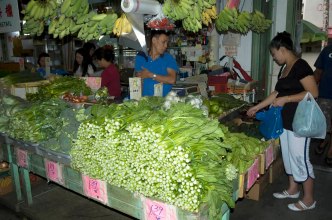

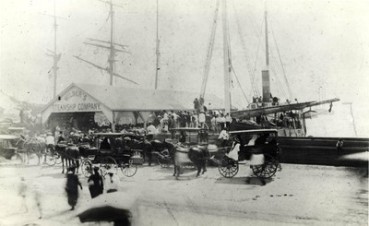


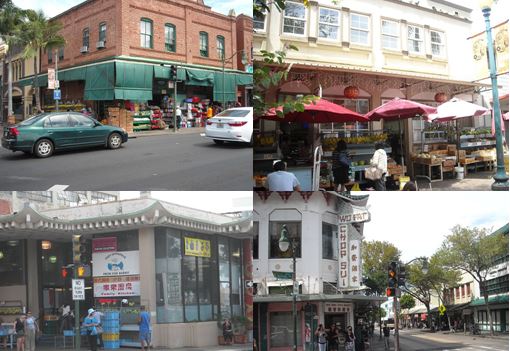
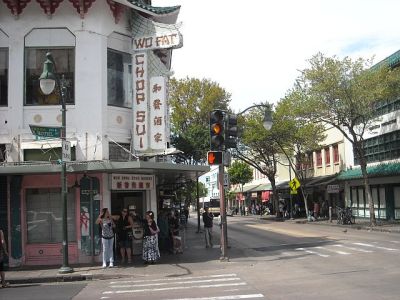

That was a fascinating introduction to the area’s history, with the background of succeeding waves of immigration.
Reminds me in a way of the east end of London…Huguenots Russian and eastern European Jews, then Bangladeshis and now Somalis….and distinctly bipolar.
Hope the little chap was not too overwhelmed.
LikeLiked by 1 person
The embarrassing truth is that Max got so overwhelmed by the sheer exoticness (is that a word?) of it all that he pooped on the sidewalk, something he never does. A passing Chinese gent launched into a stream of either curses, imprecations or maybe congratulatory remarks. We had plenty of bags so we swiftly did the clean up and moved on. I don’t blame the Fluff – between pig’s heads and dragonfruit and all the noise and commotion it was a bit much. I think the AJF felt the same way but she didn’t poop on the sidewalk.
LikeLike
And your good self?
LikeLiked by 1 person
Hehehehe….he who writes the blog controls the content, no?
LikeLiked by 2 people
Chop Sui? Any restaurant that advertised it in the open would fail in San Francisco.
LikeLiked by 1 person
Interesting observation. I lived in the Bay Area and know the SF Chinatown well and it always struck me as the more “authentic” village meaning truer to its Chinese origins. The Hawaii Chinatown is very compressed, dense and a giant melting pot of ethnicities: Chinese, Japanese, Vietnamese, Korean, Filipino, Malay, etc., all crammed together so the food tends to blur into a “Hawaii-style” version of the native cuisine. Chop suey is highly regarded here. We call those fluffy white dough buns “manapua” instead of their proper name “bao”. It’s common to mix 2-3-4 types of ethnic foods on one plate. Chop suey is probably the perfect metaphor for Hawaii in general and this part of town in particular. In SF Chinatown the Tonggs would behead you for such sacrilege.
LikeLike
Oh goody. Spam chop suey!
LikeLike
So first there were Chinese prostitutes, then Japanese prostitutes, then Chinese again. And now there are clubs and dirty people hubba-hubba-ing at various Asian naked women, not the least of which may now be Vietnamese. With all these Asian influences, what is the largest religion in Honolulu? Is there a main one for Hawaii or a bajillion? How I could possibly read the signs not written in an English alphabet to tell me where to go? I do recognize that koi; it’s on the calf of a cop friend who decided that tattooing his calf with a koi was a good idea. To me, Hawaii is what all the black velvet paintings at the Mexican restaurant depict–palm trees and ladies with long dark hair in hula skirts and coconut bras, Pina Coladas, and warm breezes. And dead pig smiles.
LikeLiked by 1 person
Well now, you are just chock full of questions! Starting with religion: most of Hawaii does not identify with a specific religion. It’s like 30-40% religious vs about 50% for the rest of the USA. Of those that do identify, Catholics are the biggest group followed by Mormons and “Eastern” religions like Buddhism, Shinto, etc. There are less than 1% Jewish or Islamic.
As to prostitution, it was a big deal in the plantation days because women had no status or way to survive if not supported by a male. Prostitution was hugely profitable and a way to survive. Later, Honolulu has always been a sailors’ delight and like all other port cities, vice is common in all forms. Today there are plenty of streetwalkers in Waikiki, houses of ill repute in downtown Honolulu and the usual escort services. Sex trafficking is a big deal and is now getting attention (finally) as the bad crime that it is.
Finally, yes, black velvet paintings are everywhere, we consider them high art, especially those of naked ladies. kittens in a basket, Elvis and the Indian with a tear in his eye; these are considered collectibles. That pig was looking at the black velvet paintings when he got nailed, that’s why he grins.
LikeLiked by 1 person
I like to eat shredded pork while looking at the velvet Elvis paintings, as is the natural order of things. Sailors do need delights, even afternoon ones. And if you’re going to hook, how much nicer in a balmy area than the frigid streets of Chicago? Makes sense to me. Except for the Catholic and Mormon part. I will have to google a cathedral in Honolulu.
LikeLiked by 1 person
You got a point. Nothing beats Elvis and a pulled pork sandwich.
LikeLiked by 1 person
Terrific post! I so enjoyed learning more about the Chinese in Hawaiian history. Working with sugar cane brought back memories of my recent trip to Florida where we visited a sugar cane plantation ruin. The work was beastly and dangerous and so, of course, was consigned to the lowest possible denominator, in Hawaii’s case the Chinese. I had no idea about the plague and wonder how many lives were saved by such quick action, cruel as it must have seemed.
I can only imagine how good the food must be there….
LikeLiked by 1 person
Invariably, when folks are asked what they like about living in Honolulu the response is “the people, the weather and the food.” That’s pretty accurate although I give the food especially high rank. There is such a diversity of items available and it all gets mixed together especially at family gatherings. Any given picnic will have at least some Hawaiian, Filipino, Chinese, Japanese, Korean and plain old American dishes. There’s also a strong Portuguese element and Vietnamese has made big inroads with Pho (a noodle soup) and some wonderful Viet/French and Viet/Italian melange dishes.
LikeLiked by 1 person
We have a thriving Vietnamese community here in Richmond and pho is one of our new food passions. There used to be a wonderful Viet/French restaurant here called Indochine. Sadly, I think it hit our food scene before palates got more adventurous. The cuisine you mention which I am not familiar with at all is Filipino. Good?
LikeLike
WOW. Thanks for the Cliff Notes version – now I know everything I need to know! Very interesting.
Tell Max that once one of he peeps took me inside the new Saks Fifth Avenue (when it was new in my town) because they accept dogs. Cool. It wasn’t so cool when I pooped on the marble floor just near the high-end dresses. Guess the fashionistas were just too much for me. Too much perfume.
LikeLiked by 2 people
Make that “one of THE peeps” – not one of “HE peeps” – I’d have to make up that kind of a story about “he peeps.” Like the ones on Ru Paul’s Drag Race.
LikeLike
That’s a funny story. I had a similar incident when the AJF and I were at the Saks in Las Vegas and she showed me the price of the dress she wanted. They made me clean up my own mess too but then they threw me out.
LikeLiked by 1 person
Geoff gets upset whenever I spend more than $20.00 on clothing. As he gets much of his clothing at IT trade shows, he doesn’t appreciate how much clothes cost. He isn’t happy that I broke my foot but it has certainly slowed down my spending and as for buying shoes, that;s stopped – except for a replacement pair of joggers I bought last weekend. I’m hoping they might yet become fashionable.
LikeLike
Like many countries, Australia also has its Chinatown. The Chinese flocked to Australia duribng the goldrushes in the 1850s and weren’t very popular because they were much more industrious and found gold in the wastes of the other miners.
LikeLike
Wow I can’t believe I missed this post until today! Yet another spell-binding entry on life in the islands. Loved the history lesson and the photos, notwithstanding the smiling pig which was disturbing on so many levels. I’d probably be like Max on the sidewalk–seems like way too much stimuli for anyone to take in. 😉
LikeLike